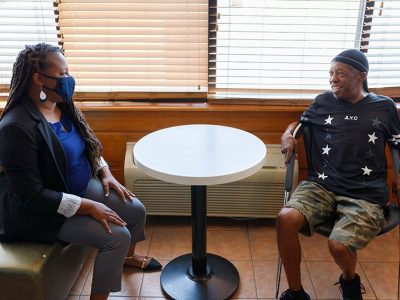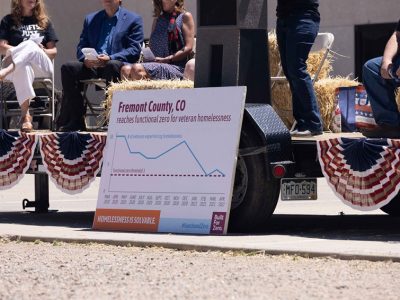Homelessness is solvable — nowhere has that been demonstrated more clearly than in the progress to end veteran homelessness.
Twelve communities across the country have reached and sustained a measurable end to veteran homelessness called functional zero. Here’s what we can learn from their progress.
1. You need a by-name list of every veteran experiencing homelessness to get to functional zero.
All of the communities that have reached functional zero for veterans started by achieving quality, real-time, person specific data. A by-name list accounts for every veteran in the community who is experiencing homelessness. It includes information like their housing needs and history of homelessness.
Next, communities use this list to find housing solutions for everyone on it — while keeping the list updated with anyone new who enters into homelessness. They also use this data to hypothesize strategies to improve their system and test new ideas. By understanding how the overall number of veterans experiencing homelessness is changing month over month, the community can track whether these interventions are driving population level reductions in homelessness (see number 3, below).
“It’s living data. It’s constantly being updated and kept current,” said Jennifer Jaeger, who is Community Services Director at City of Rockford, Illinois. Rockford reached functional zero for veteran homelessness in 2015.
2. No single agency can end homelessness across a community — it takes a team.
Built for Zero helps communities build a unified regional team with a shared aim of getting to functional zero for a population. They focus their improvements on target populations as they move toward systems that can end homelessness for all.
In many communities, the homeless response system is fragmented and siloed across multiple agencies. Often, success is defined by each organization’s programmatic goals rather than whether the overall number of people experiencing homelessness decreases.
In Lynchburg, Virginia, for example, 32 agencies were working on veteran homelessness. The team unified their efforts and got them working together. They started having weekly “veteran huddles,” where the agencies would work together to house veterans. This collaboration shortened the average amount of time veterans remained homeless, and in February of 2020, they reached functional zero.
“Every member of the veteran huddle was really committed to improving housing placements for homeless veterans and each had a unique service and skillset to offer to make that a reality,” said Sarah Quarantotto, Executive Director of Miriam’s House.
3. Testing new ideas is key.
Once communities have created quality, by-name data of everyone experiencing homelesssnness, they are ready to start hypothesizing strategies and testing new ideas. Using quality improvement methods, they come up with ideas intended to drive homelessness down. Then, they look to their data to see if these interventions are working.
For example, in Lake County, Illinois, their homeless response system required that people go through shelters in order to receive access to permanent housing. The local team recognized this was a potential barrier.
“There were so many reasons why people might not want to come into shelter,” said Brenda O’Connell, who worked as the Continuum of Care Program Coordinator of Lake County when they reached functional zero. “For example, ‘I have a pet who is my life, and I will not leave them for the night.’ Or ‘I have a serious mental illness and sleeping in a room with 20 other people is not something I can do.’”
So, they tested other ways to connect veterans who were not visiting shelters to permanent housing solutions.
4. It’s possible to dramatically decrease the amount of time it takes for a community to house a veteran.
The Gulf Coast Region of Mississippi became the first community to reach functional zero for veteran homelessness in 2015.
They were able to achieve this by improving their homeless response system, increasing the speed of housing local veterans who had experienced homelessness. At one point, they had reduced the time it took from identifying a new veteran experiencing homelessness to placing them in housing to just 14 days.
5. Some places can end veteran homelessness without increasing housing supply by focusing on systems improvements.
Without question, expanding access to affordable housing is a critical link to ending homelessness in some cities. But cities are also able to make progress by improving their existing homeless response systems.
So far, 93% of Built for Zero communities that have reached functional zero chronic or veteran homelessness did so without increasing their housing supply. How is this possible? Because to end homelessess, you need more than just housing — you need a system that can effectively connect that housing to the people who need it.
This was the case in Chattanooga, Tennessee, a continuum of care region that covers nearly 700,000 people that reached functional zero for veteran homelessness in October of 2019.
“We were definitely the community that thought we didn’t have resources [to end veteran homelessness], but it turns out it wasn’t true at all,” said Emma Beers, who helped the Chattanooga and Southeast Tennessee community functionally end veteran homelessness in her previous role. “Change started happening without it.”
6. It’s possible to make progress — and even functionally end — veteran homelessness during a pandemic.
Two communities reached functional zero for veterans in the midst of the COVID-19 pandemic.
Fremont County, Colorado, had achieved quality, by-name data when the pandemic hit in March 2020. They reached functional zero for veteran homelessness a year later. The community took advantage of the fact that they had temporarily housed people experiencing homelessness in hotels and motels, in order to provide safer accommodations than congregate shelters. They worked to find permanent housing for the people temporarily quarantined in hotels.
Across the country, Crater Region, Virginia, also reached functional zero. The community both managed the challenges posed by COVID and simultaneously seized opportunities afforded by the new federal resources available for responding to needs of people experiencing homelessness.. The team was able to leverage funding from the CARES Act to help people experiencing homelessness into housing and assist people at risk of homelessness by using available rent and mortgage relief funding.
“The pandemic increased the work we had to get done and made it even more urgent. We couldn’t slow down and had to do even more to pick up the pace,” said Erica Holmes, Crater Region Team Lead and Director of Program Operations at St. Joseph’s Villa.
7. Communities have used their learning from reaching functional zero for one population to accelerate getting to functional zero for more groups.
In January of 2017, Rockford, Illinois, became the first community in the United States to end both chronic and veteran homelessness. Since then, two other communities — Bergen County, New Jersey, and Abilene, Texas — have reached functional zero for both veteran and chronic homelessness too.
Communities in Built for Zero often start by focusing on the veteran and chronic population, with the goal of expanding these results to other populations as they work toward ending homelessness for all. This includes all single adults, youth, and families.
“Once you’ve ended homelessness for one group, nothing seems impossible,” said Julia Orlando, director of the Bergen County Housing, Health and Human Services Center and Built for Zero community lead in Bergen County.
8. Communities have sustained an end to veteran homelessness.
Functional zero isn’t a finish line: it’s a continuous reality that must be protected. Once communities reach functional zero a first time, they must keep working to maintain a system where homelessness is rare overall, and brief when it occurs.
Communities like Rockford, Illinois, and Bergen County, New Jersey, sustained an end to veteran homelessness. Since people will continue to enter into homelessness, functional zero is a measure of how resilient and responsive a communities’ homeless response systems can be to the needs of people at risk of, and experiencing, homelessness.
“It just doesn’t stop once you reach functional zero. We have to have systems in place to keep that momentum,” Erica Holmes from Crater Region, Virginia. “Because people are going to continue to have housing crises but if we can catch it and connect them to a resource, we’re doing our jobs.”





